- TOP
- Gardens & Shops
- garden
- paid garden
- Awaji Island Akashi Kaikyo National Government Park―A Treasure Trove of Instagrammable Scenery
Awaji Island Akashi Kaikyo National Government Park―A Treasure Trove of Instagrammable Scenery
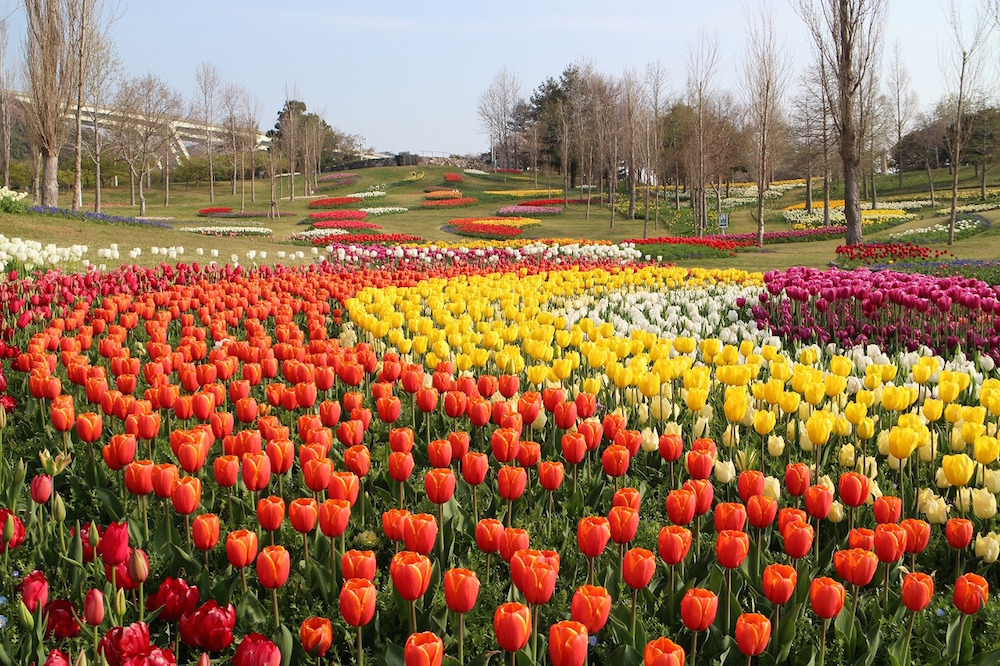
In Japan, where the four seasons are distinctly marked, there are many gardens that attract attention from around the world for their lush landscapes, wide range of plants, and technical skills in making flowers bloom beautifully. Across the country, there are many blooming spots that impress visitors. Let us guide you to breathtaking tourist gardens that you should visit at least once in your lifetime. This time, we’re introducing the charm of Awaji Island Akashi Kaikyo National Government Park (hereafter “Akashi Kaikyo Park”), where visitors can enjoy beautiful seasonal flowers all year round.
Contents
ToggleAkashi Kaikyo Park
A Park of Ever-Changing Scenery Throughout the Year
Opened in its first phase in 2002, the Akashi Kaikyo Park was developed with the goal of restoring the natural environment of a large-scale, 100-hectare(247ac) former soil excavation site and creating an international, resort-like seaside recreational space. As of July 2022, 43.1 hectares(107ac)—approximately 45% of the planned area—have been opened to the public.
The gardens within the park take full advantage of the vast grounds, showcasing dynamic displays through mass plantings of seasonal flowers. The impressive flower beds create stunning scenes, beginning with daffodils in spring, followed by tulips, Livingstone daisies, hydrangeas, sunflowers, cosmos, and finally Christmas roses in winter—offering a spectacular view throughout the year.
The planting plan is changed every year to give the gardens a new look, attracts many repeat visitors. Aiming to be a “garden perfect for Instagram-worthy photos,” it offers a variety of creative photo spots, making it an ideal place to capture plenty of memorable pictures.
In addition to the garden, there is a barbecue area and “Yumekko Land,” a large playground complex with 150 different play structures, making it a place where families can spend an entire day without getting bored.
A Stunning Display of Synchronized Blooms
Don’t Overlook the Striking Tulip Beds in Full Color!
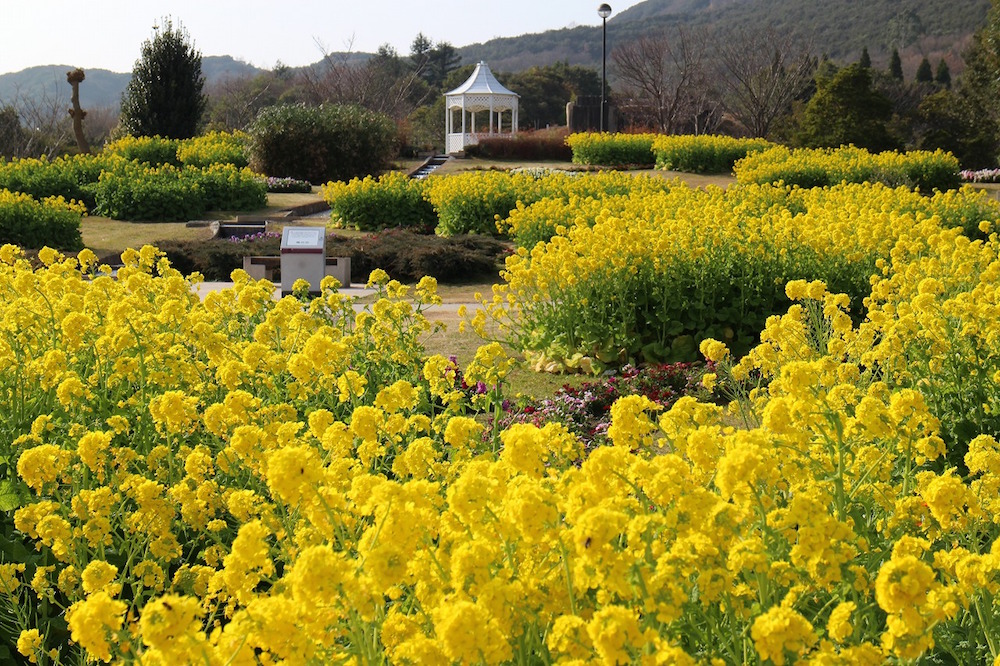
On Awaji Island, blessed with the mild climate of the Seto Inland Sea, the best time to see early-blooming Nanohana (rapeseed flowers) is from January to early February.
Standing in front of the floral scenery of the “Utsuroi-no-niwa Garden (Garden of Transitions),” which features lawns and flowing water, makes one’s heart leap with the feeling that “Spring is just around the corner!”
From the gazebo perched on a gentle hill, you can enjoy a stunning view of the ocean beyond a perfect backdrop where the blue sea and yellow flowers create a vivid contrast.
Visitors are welcome to bring their own food into the park, so it’s also a perfect place to relax and enjoy a picnic lunch.
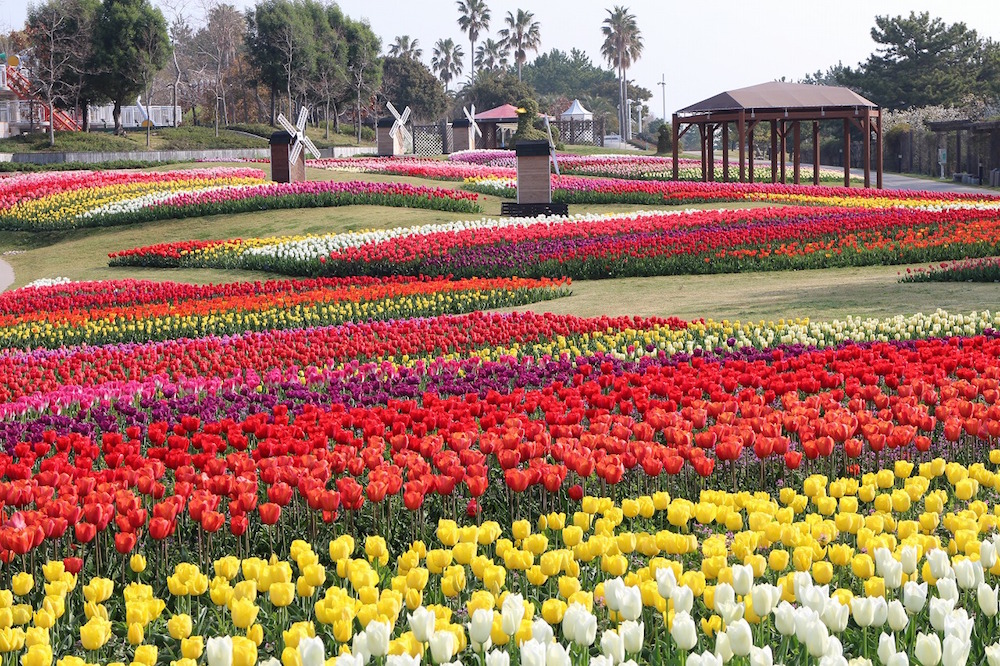
From late March to mid-April, tulips reach their peak bloom. In 2025, a total of 168,000 tulips from 100 different varieties blossomed across flower beds spanning approximately 4,600 square meters (1.14ac) in the combined areas of “Hill of Cottonwood” and “Daichi-no-niji Garden (Rainbow of the Earth Garden).”
The colorful garden, backed by a meticulous planting plan that aligns bloom times and plant heights by variety, offers a truly impressive sight. Each year, a new theme is chosen and the color scheme is changed, creating dynamic, large-scale displays that attract many repeat visitors.
During the peak season, the Spring Carnival is held. Various hands-on activities are held each year, including a photo session where visitors can try on traditional Dutch costumes. The windmill seen in the background of the photo is inspired by Netherlands and is set at about human height, making it a popular photo spot.
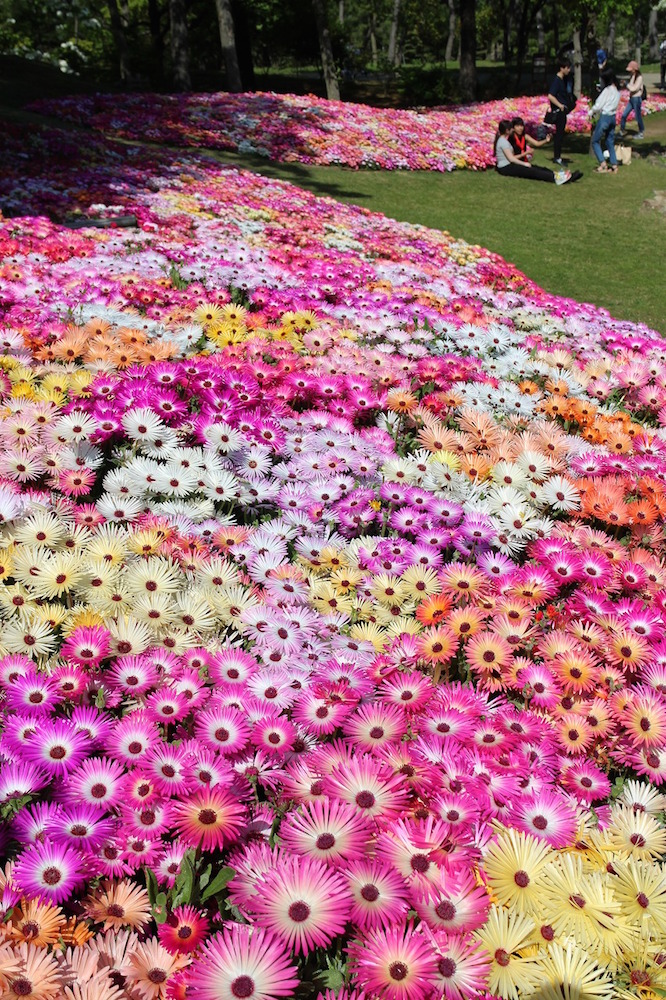
The best time to see the Livingstone daisies is from mid-April to early May. Approximately 15,000 plants are planted on 600 square meters (0.15ac). Taking advantage of their ground-hugging growth habit that creates a carpet-like effect, a mix of vibrant colors is used to create a stunning display. Sparkling in the sunlight like precious gems, Livingstone daisies create a mesmerizing sight. Since they bloom in response to light, it’s best to visit on a sunny day to fully enjoy their beauty.
Within Akashi Kaikyo Park, the “Yume Hatchi Tram Car” runs every 30 to 60 minutes. A guide staff member rides along, introducing visitors to the park’s blooming spots during a one-way 10-minute ride. Unlimited rides are available for 300 yen per day.
Please Note: The Yume Hatchi Tram Car is currently out of service due to a vehicle malfunction.
Pets are welcome in the park (except inside buildings and on park vehicles). Enjoy a walk while viewing the Livingstone daisies from above. Please note that leashes are required at all times, and be sure to follow proper etiquette, such as cleaning up after your pet.
Smoking is prohibited in the park. However, designated smoking areas are available, so smokers are asked to use those locations when taking a break.
Seas of Hydrangeas, Lilies, and Sunflowers in SummerEnjoy the Breathtaking Scenery of Vibrant Flowers in Full Bloom!
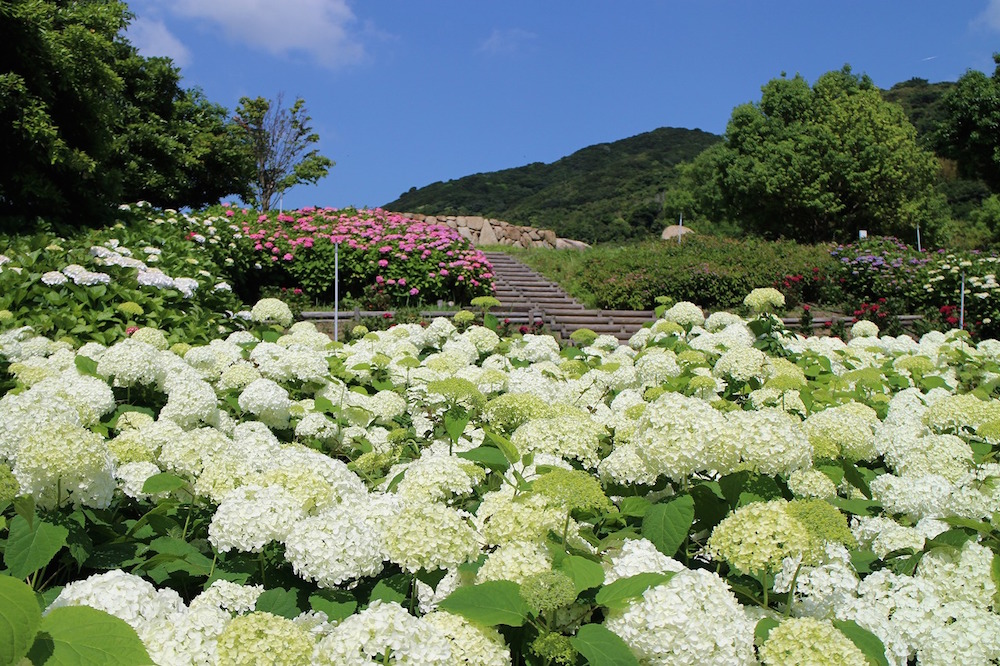
From early June to early July, hydrangeas reach their peak bloom, with around 14,000 plants from approximately 16 varieties beautifully coloring the park. In the foreground, the American hydrangea Annabelle is especially popular for its elegant transformation—from a fresh lime green at the start of blooming to a pure white as it matures.
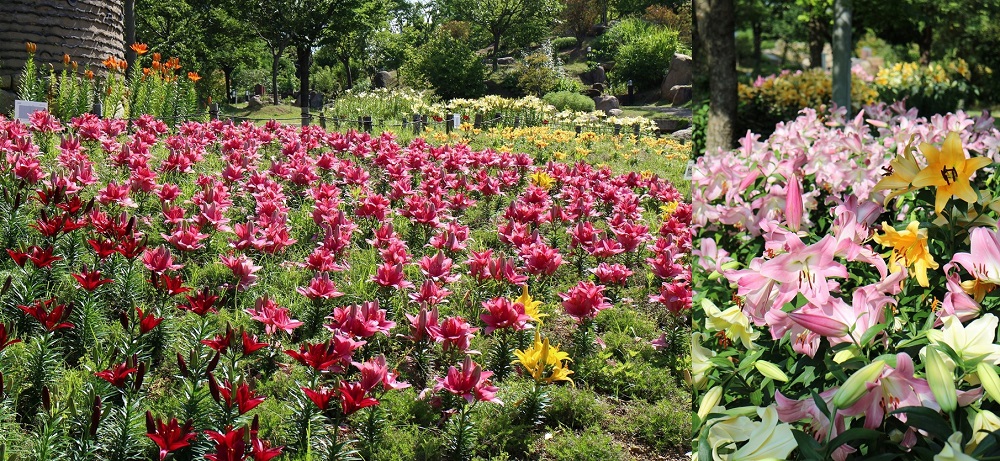
The best time to see lilies is from early June to mid-July. About 12,000 plants of about 35 varieties are planted throughout the park.
In sunny areas, you’ll find brightly colored Thunberg Lily, while in partially shaded spots like under trees, varieties such as the Brilliant Lily and Regal Lily are planted to suit their growing conditions.
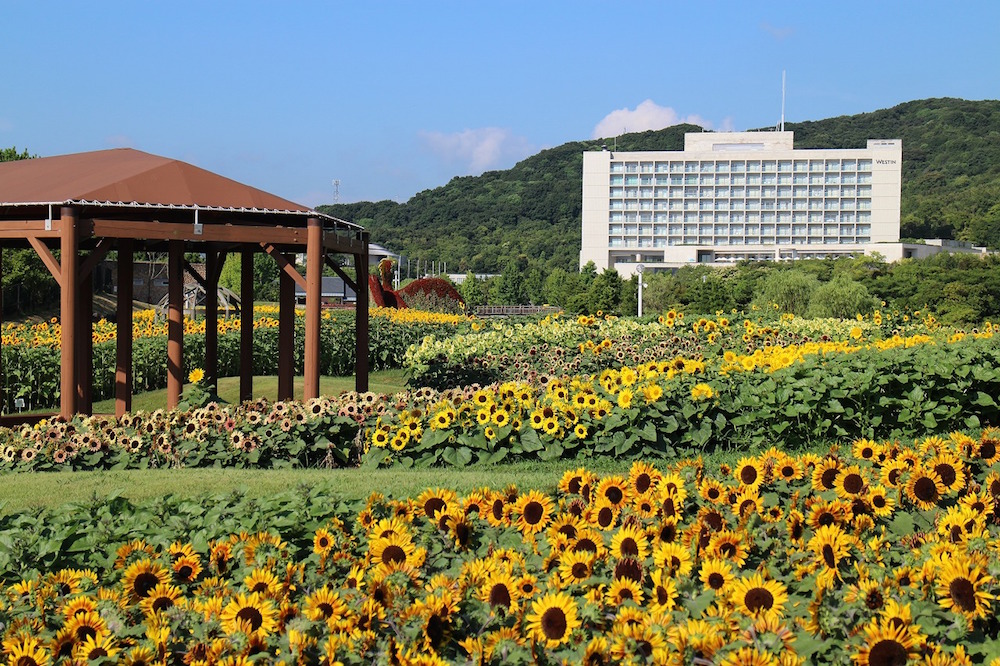
In the north and south areas of “Daichi-no-niji Garden (Rainbow of the Earth)”, sunflowers reach their peak bloom from early July to mid-August. Around 36,000 plants of approximately 40 varieties—each with different flower colors and shapes—are planted. Winding walking paths follow the gentle slopes of the hills, making it a popular spot each year for taking photogenic shots with the sunflower fields as a backdrop. To extend the blooming season, the sunflowers are planted in phases: the southern area begins to bloom in July, while the northern area starts flowering in August.
Autumn Dahlias and Cosmos, Winter Christmas Roses
A Garden You’ll Want to Visit Again and Again, All Year Round
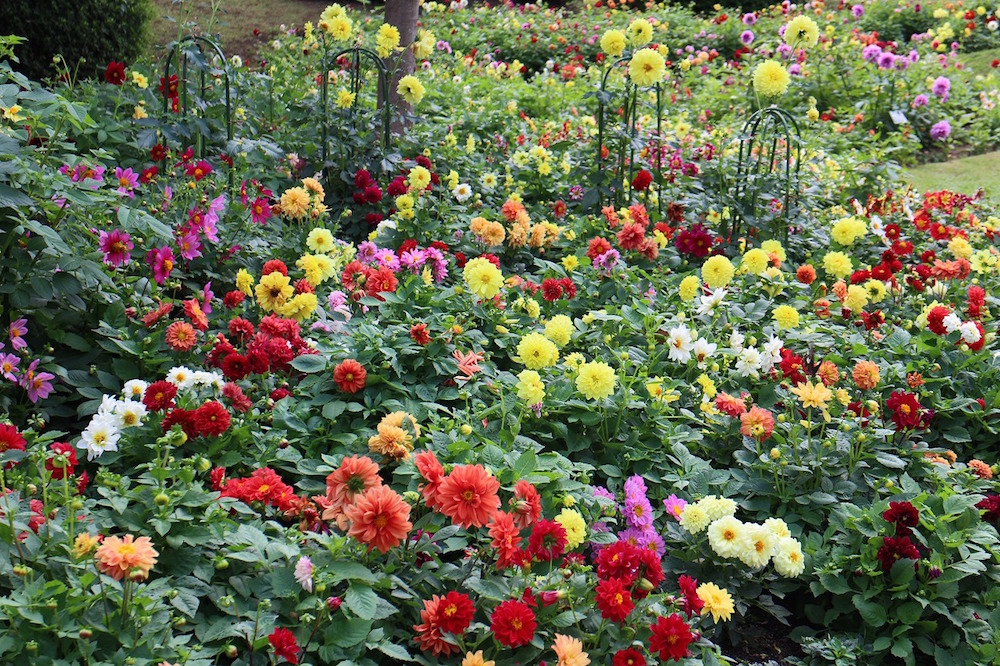
Dahlia season is from late September to late October. In an area of about 600 square meters (0.15ac), 10,000 plants of about 6 varieties of dwarf species and 160 plants of about 40 varieties of large-flowered tall species are planted. With the tall varieties forming a backdrop, the foreground bursts with a vibrant mix of colorful dwarf dahlias, making this a popular and highly photogenic spot in autumn.
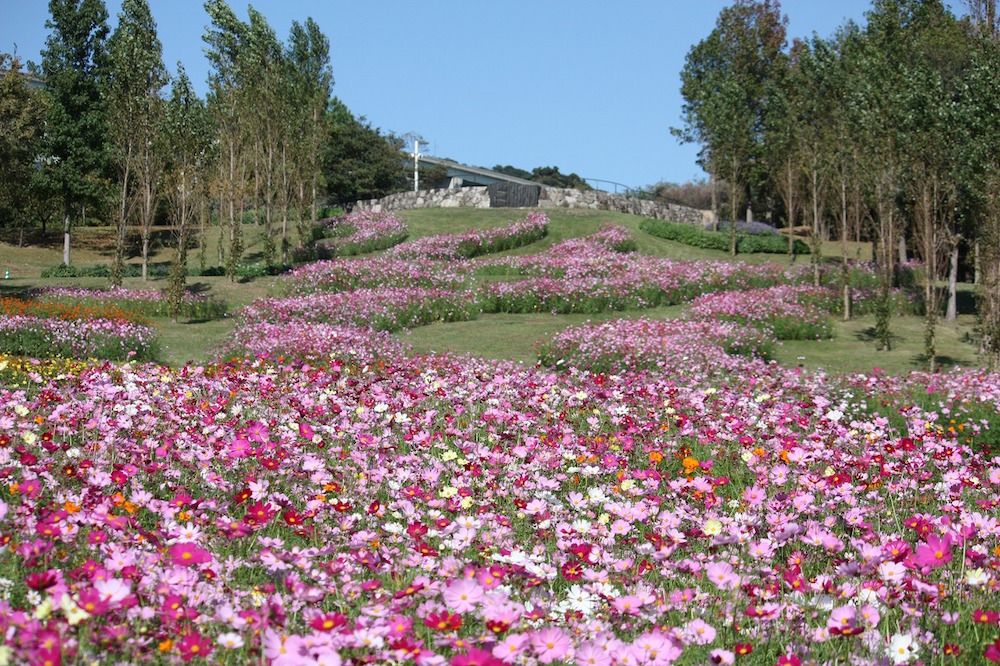
From late September to late October, cosmos take center stage. A total of 50,000 cosmos flowers of about 20 varieties, including 16 varieties with different colors and shapes and 4 late-blooming varieties such as the “Campus Series,” will be at their best.
In the “Hill of Cottonwood” area shown in the photo above, various flower colors are mixed together in the planting design. On the other hand, the “Daichi-no-niji Garden (Rainbow of the Earth Garden)” flower bed is designed to create a striped rainbow pattern by planting flowers in different colors, such as red, shades of pink, white, and yellow, allowing visitors to enjoy two different planting techniques.

From late December to early April, Christmas roses are in full bloom, adding charm even in winter. Currently, around 1,500 plants from approximately 130 varieties—including species and interspecific hybrids—are planted, with new varieties added each year. The garden has become a beloved destination for Christmas rose enthusiasts.
Each year in March, a workshop is held at the Christmas Rose Garden. During the one-hour session, participants are guided through the introduction of various varieties and basic care tips. The Christmas rose variety shown in the right photo is Helleborus x ericsmithii ‘Snow Dance’.
The Adorable Charm of Tako-san, the headband wearing Octopus!
A Unique, Instagram-Worthy Photo Spot

Let’s introduce a unique corner featuring objects decorated with flowers. On the left is a topiary of Tako-san (Octopus), a local specialty of Akashi. With its twisted headband and goofy expression, it’s simply adorable. Although not pictured, there’s also a sea bream nearby.
On the right is the “Hanahidori (Phoenix Firebird)”, a symbol of recovery from the Great Hanshin-Awaji Earthquake.
Both topiaries stand around 3 meters tall and are truly impressive in scale. Depending on the season, they are decorated with flowers like violas, begonias, and achyranthes. This highly popular photo spot is known for its charming displays that are sure to bring a smile and make for Instagram-worthy shots.
During the peak seasons of spring and autumn, free guided tours by expert staff are offered. The tour takes about an hour and allows visitors to leisurely explore the park—be sure to join if you have the chance!
Please note: The number of plant varieties and the total number of plantings in the park may vary from year to year.
Local Specialties at the Restaurant and Gift Shops
Within Akashi Kaikyo Park, you’ll find the restaurant “Hanayashiki”. If you’re tired from walking around the spacious grounds, it’s a perfect place to take a break. The restaurant is open from 10:00 am. until one hour before the park closes (hours vary by season). The last order is taken 30 minutes before closing.
Lunch prices range around 1,000 yen, and a popular recommendation is the local specialty Awaji Nama-Kama Don—a fresh whitebait rice bowl available only from April to November. It comes with onion soup and costs 1,080 yen.
There are 40 indoor seats and 40 terrace seats available.
The park’s gift shops offer a wide selection of local specialties from Awaji Island—perfect for souvenirs. Recommended items include the island’s famous onion soup (540yen), onion rice crackers (540yen), and the park’s original sweet buns (700yen). Be sure to stop by!
Information
Akashi Kaikyo Park
Address: 8-10 Yumebutai, Awaji City, Hyogo/Japan
Call: 0799-72-2000
Official Website: https://awaji-kaikyopark.jp/en/index.html
Access:
【By Train and Bus】
<From Kobe/Osaka>
From Shin-Kobe and Sannomiya: About 60 minutes by express bus for “Higashiura Bus Terminal”
Alight at Yumebutai-mae Bus Stop
When alighting at JR Maiko Station: About 15 minutes from Kosoku Maiko Bus Stop by express bus for “Higashiura Bus Terminal”
Alight at Yumebutai-mae Bus Stop
Take a high speed boat from Akashi Port to Iwaya Port, and then take a bus from Iwaya Port Bus Stop for about 10 minutes
Get off at Yumebutai-mae Bus Stop
※For a detailed map and further information, including directions for both public transport and driving, please click here.
Days Closed:
December 31, January 1, and the Second Monday to Friday of February
Opening Hours:
From April 1 to June 30 9:30-17:00
From July 1 to August 31 9:30-18:00
From September 1 to October 31 9:30-17:00
From November 1 to March 31 9:30-16:00
Admission:
Adults(aged 15 to 64): 450 yen
Seniors(65 and over): 210 yen
*Free for children under 6 years old.
Credit
Interview & Text / Osada Setsuko

Writer&Editor.
Specializes in lifestyle topics, focusing on gardening, interior design, and housing.
Became independent and started working as a freelancer after working for an editorial production company for about 10 years from 1994.
Enjoying gardening with balcony garden.
Translation / Garden Story Editorial Team
Latest Articles
-
garden
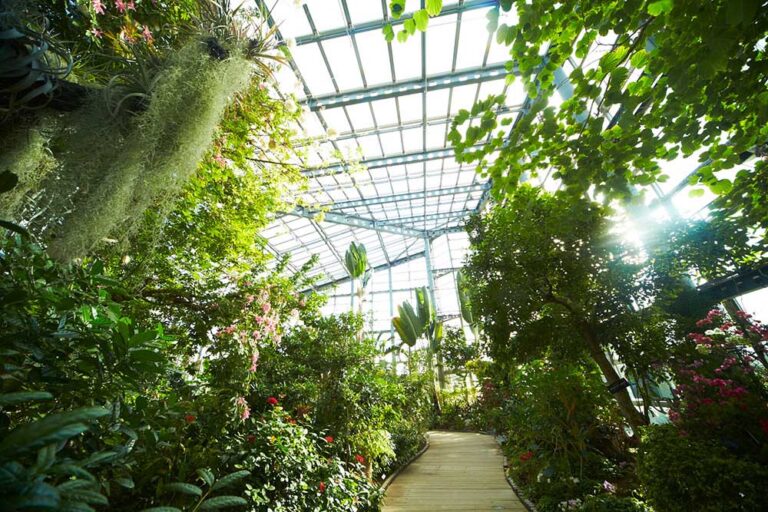
Sakuya Konohana Kan―A Greenhouse Botanical Garden Full of Hands-On Experiences
Sakuya Konohana Kan conservatory is a two-story greenhouse made of glass and steel, and one of the largest botanical gardens in Japan. In winter, when greenery becomes scarce, strolling through its w…
-
garden
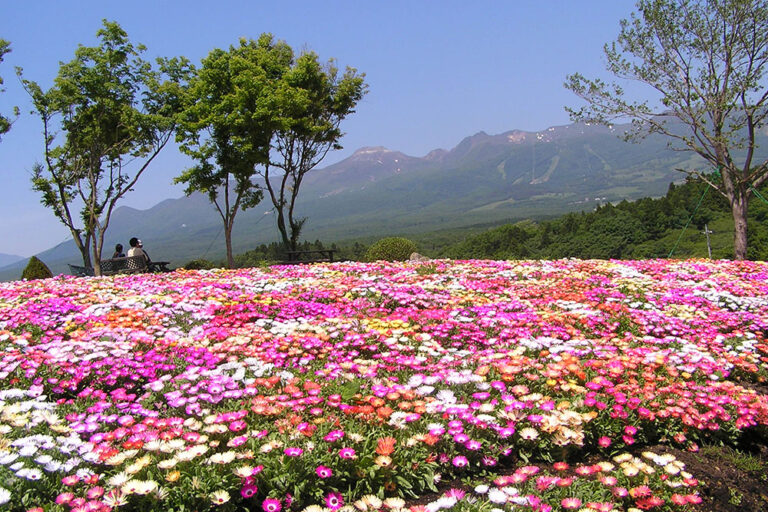
Nasu Flower World―Breathtaking Fields of Blossoms
Nasu Flower World is a tourist garden located in the popular resort area of the Nasu Highlands. Making full use of its vast grounds, the garden features sweeping mass plantings of seasonal flowers, c…
-
garden
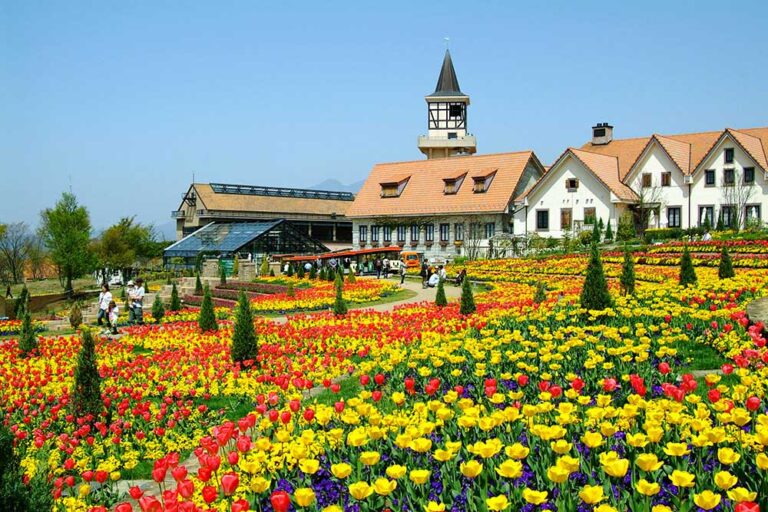
Heidi’s Village―A Beloved Theme Park and Flower Paradise
Heidi’s Village, known as the theme park of the classic anime Heidi, Girl of the Alps, is also a popular tourist destination with the charm of a flower park. Among its highlights is Japan’s longest “…
